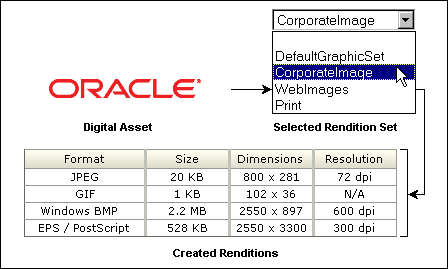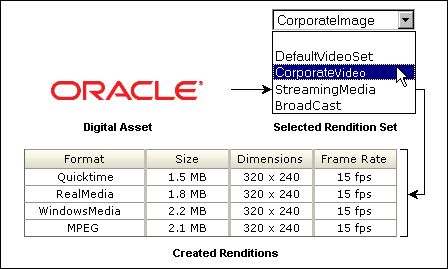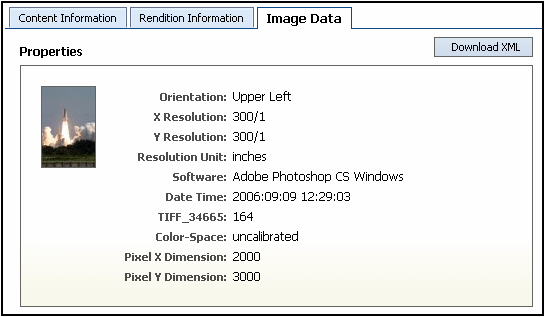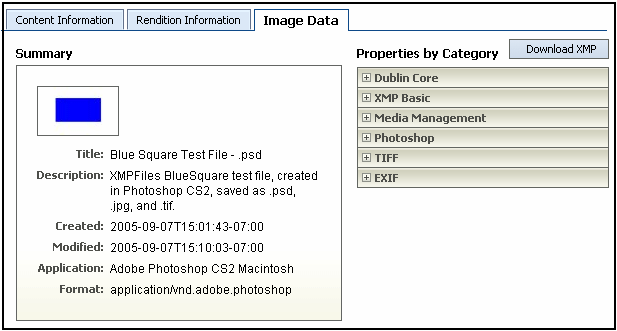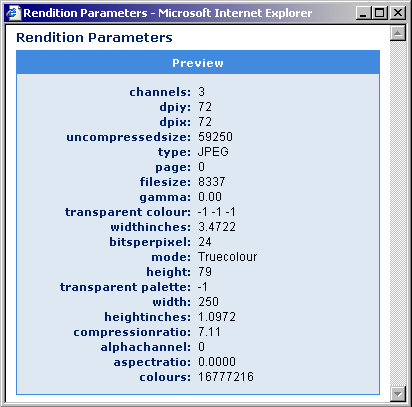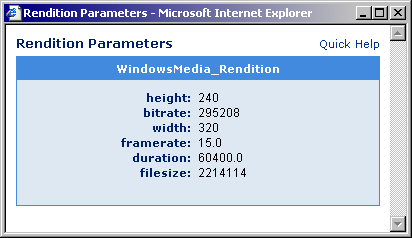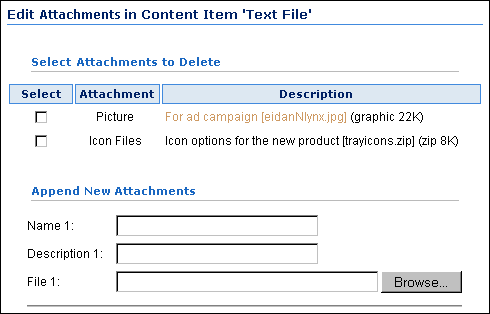24 Working with Images and Videos
This chapter describes how to use Oracle WebCenter Content Server to manage digital assets and quickly find, group, convert, and download images and videos of various sizes, formats, and resolutions.
This functionality is installed but disabled by default. Your system administrator chooses whether to enable this functionality for your site. The chapter covers the following topics:
-
Section 24.1, "About Digital Asset Management with Oracle WebCenter Content"
-
Section 24.12, "Managing Digital Assets on a Macintosh Client"
24.1 About Digital Asset Management with Oracle WebCenter Content
Using Oracle WebCenter Content to manage digital assets enables you to quickly find, group, convert, and download images and videos of various sizes, formats, and resolutions to meet your business requirements, while maintaining a consistency of use across your organization. For example, an organization may have a logo in a variety of sizes for advertisements, Web pages, and presentation, or a training video in a variety of formats for streaming on an intranet, presenting to an audience, or copying to tape.
Work with your system administrator and other contributors to define the appropriate size and output. At check-in, the digital asset is automatically converted into the defined formats and sizes, known as renditions. You can then search for the asset using standard metadata or closed-caption text if it is a video asset. From the Rendition Information page you can add renditions to a digital asset basket and download a single compressed file that contains all of the renditions.
When enabled, the ability to manage digital assets adds the following pages to Oracle WebCenter Content Server:
-
Add/Edit Attachments page
The ability to manage digital assets also adds functionality to the Content Check-In, Content Information, Content Information Update pages, all search result pages, and the My Content Server tray.
The ability to manage digital assets enables you to create and find images and videos in specified formats and sizes. This helps your organization maintain consistent standards for branding and asset use, while providing the right content to the right people in the right format.
Managing digital assets allows you to create multiple formats of digital assets automatically when they are checked in to Oracle WebCenter Content Server, and lists the formats under one content ID. Digital assets, such as a corporate artwork or commercial videos, maintain a standard size and quality in each format required by your organization. The content management and workflow features of Oracle WebCenter Content Server uses only approved versions because assets are created from a single source managed by Oracle WebCenter Content Server.
Managing digital assets with Oracle WebCenter Content Server gives you the confidence that you are using the approved asset in the proper format. For example, an image of the logo in a format for use on a Web-site can be bundled and downloaded with other formats of the logo for use in office presentations or print collateral, all from a single digital asset checked in to Oracle WebCenter Content Server. Or, a low-bandwidth version of a training video can be posted to a streaming server while a high-bandwidth version can be provided to a vendor for replication to tape or DVD.
Each format created of a digital asset is called a rendition. Each image rendition includes information about size, color, format, and other criteria defined by your system administrator. Each video rendition includes information about display size, bandwidth, and expected use. Renditions are grouped into rendition sets. When you check in a digital asset, you choose a rendition set, which then determines what renditions are created for the asset. When finding a digital asset for use, all renditions of the asset are listed on the asset's Rendition Information page, and are available for download.
24.2 Supported Input Formats
Supported input formats are determined by the graphic or video conversion application as set up by your system administrator.
Common image input formats include the following:
-
JPG/JPEG (Joint Photographic Expert Group)
-
GIF (Graphics Interchange Format)
-
BMP (Bitmap)
-
PNG (Portable Network Graphics)
-
TIFF (Tag Image File Format)
-
PSD (Adobe Photoshop)
-
AI (Adobe Illustrator)
-
PDF (Portable Document Format)
Common video input formats include the following:
-
Flash Media Format
-
MPEG Layer 3 and 4 Elementary Stream Media Format
-
PacketVideo MPEG4 Format
-
QuickTime Media Format
-
QuickTime Streaming Format
-
Windows Media Format
-
AVI Media Format
-
DVD Stream Media Format
-
MPEG1 System Stream Media Format
-
MPEG2 Program Stream Media Format
-
MPEG2 Transport Stream Format
-
MPEG4 Media Format
-
Pinnacle MediaStream Media Format
For a comprehensive listing of supported format, see the conversion application documentations.
Formats supported by the conversion application must also be associated with the conversion process within Oracle WebCenter Content Server by the system administrator using the Oracle WebCenter Content Server Configuration Manager. If a supported format is not rendering, see your system administrator.
24.3 Supported Video Output Formats
Output formats are limited to what your browser displays effectively. Only output formats supported by Windows Media Player, Real Player, Flash Player, or Quicktime Player are available for viewing in your Web browser. Any assets rendered in a format not supported by those players is still be managed by Oracle WebCenter Content Server, but is available only for download only.
Oracle WebCenter Content currently supports the following video output formats:
-
MPEG Layers 1, 2, and 4 (.mpg, .mpeg, .mp2, .mp4)
-
Quicktime (.mov)
-
Audio Video Interleave (.avi)
-
Flash Video (.flv)
Other output formats not listed here but supported by your media player may work when set up properly by your system administrator. For additional format requests, see your system administrator. For information on formats supported by your media player, see the player's help system.
24.4 Checking In a Digital Asset
When the ability to manage digital assets is added to Oracle WebCenter Content Server, the Rendition Set list is displayed on the content check in form.
To check in a digital asset, perform these steps:
-
Open the content check-in form.
-
Choose a rendition set from the Rendition Set list.
-
Enter a title and any additional metadata for the asset. The title you enter must be 249 or fewer characters in length.
-
Click Browse to locate the primary file.
-
Click Check In.
Oracle WebCenter Content Server uses the file extension, such as .psd, .jpg, .mov, or .avi, to determine if an item is a digital asset. Digital assets checked in to Oracle WebCenter Content Server must have the correct file extension appended to the file name. For example, a Photoshop file named CorporateLogo.psd is correctly identified by Oracle WebCenter Content Server as a digital asset, but one named CorporateLogo is not.
Do not select an alternate file when checking in a digital asset. Doing so prevents the primary file from rendering.
24.5 Finding Renditions and Information
Searching for digital assets is identical to searching for other types of content. Digital assets have an additional icon displayed in the standard Search Result page. The Rendition Information icon links to the Rendition Information page of the asset.
Because you are working with images and videos, you may want to set your default search result view to Thumbnail View. To do so, choose Thumbnail View from the Content Actions menu on a Search Result page.
24.6 Rendition Information Page
When a digital asset is checked in to Oracle WebCenter Content Server, multiple renditions are created based on the rendition set chosen at the time of check-in. Just like with standard content, information about the original content item is indexed and displayed on the Content Information page. However, with a digital asset, information about the created renditions is also displayed on the Rendition Information page, and on the story board and any closed-captioned text for video assets.
To access the Rendition Information page, click the associated link on the Content Information page, or from a search result page using the Rendition Information icon or the Rendition information link in the item Actions menu.
Accessing The Rendition Information Page
To access the Rendition Information page of a digital asset from any page in Oracle WebCenter Content Server, perform one of these steps:
-
Search for the digital asset for which to view rendition information.
-
Click the Rendition Information icon next to the appropriate digital asset on a Search Result page, or choose Rendition Information from the item Action menu.
Alternately, you can access the Rendition Information page from the digital asset basket by performing these steps:
-
Click the My Content Server tray, click My Baskets, and then click Digital Asset Basket.
-
Click the Rendition Information icon next to the appropriate digital asset in your digital asset basket.
When the Rendition Information page opens, click the tabs at the top of the page to switch between the Content Information page, the Rendition Information page, and the Image Data page for the asset.
24.7 Image Data Page
The Image Data page displays information about the native image file checked in to Content Server. However, what that information is and how it is displayed is contingent on:
-
The specific information the camera or application captures, and
-
Whether the image is generated by a digital camera or an application (such as Photoshop).
The specific information that is displayed is dependent on the type of camera or application used to generate the image. Different digital cameras collect different information, depending on the camera features and capabilities.
Additionally, one camera might have a built-in GPS system and can record GPS coordinates into the image file. Another camera might not have that capability, and so wouldn't be able to output that information to the Image Data page. Similarly, an application such as Photoshop may generate information specific to its feature set while Paint Shop Pro would generate different information specific to its different feature set.
How the information is displayed on the Image Data tab is dependent on whether the native image file is a JPEG from a digital camera or if it is from an application. Digital cameras store information using the EXIF standard (Exchangeable Image File format), which is a subset of the XMP standard (Extensible Metadata Platform). Both methods use the Oracle Outside In filters to generate XML to structure the data.
If the image is a JPEG from a digital camera, Outside In specifies the document type as JPEG File Interchange, and the EXIF data is displayed on the Image Data tab in a flat listing. If the image is from an application such as Adobe Photoshop, Outside In specifies the document type as coming from the application (for example, document type="Adobe Photoshop"), and the XMP data is displayed on the Image Data tab with some hierarchical structure.
Note:
If the image is a digital photograph that has been manipulated in Photoshop, the EXIF data gets aggregated and formatted as part of the XMP data, because EXIF is a subset of XMP.
Figure 24-7 shows the contents of the Image Data tab for a checked in digital photo. In this case, the information includes the image thumbnail and the photo's digital properties.
Figure 24-8 shows the contents of the Image Data tab for a Photoshop document with the XMP data displayed in a hierarchy.
To access the Image Data page of a digital asset from any page in Oracle WebCenter Content Server, perform one of these steps:
-
Search for the digital asset for which to view rendition information.
-
Navigate to either the Rendition Information page or the Content Information pages, and click the Image Data tab
-
Click the Image Data tab.
Alternately, you can access the Image Data page from the digital asset basket by performing these steps:
-
Click the My Content Server tray, click My Baskets, and then click Digital Asset Basket.
-
Click the Rendition Information icon next to the appropriate digital asset in your digital asset basket.
When the Image Data page opens, click the links at the top of the page to switch between the Content Information page, the Rendition Information page, and the Image Data page for the asset.
24.8 Rendition Parameters Page
To access the Rendition Parameters page, click the Rendition Name Information icon next to a rendition name on the Rendition Information page.
If an image rendition fails, the format column in the Renditions section of the Rendition Information page displays Not Converted for that rendition. In the case of a failed rendition, the Rendition Parameters page displays information about the cause of the failure.
Accessing The Rendition Parameters Page
To access the parameters of each specific rendition, perform these steps:
-
Access the Rendition Information page.
-
Click the Rendition Name Info icon.
24.9 Video Preferences Page
To play a video rendition, use the preview section of the Rendition Information page or click a Web-viewable link on the Content Information, digital asset basket, or Search Result pages. Oracle WebCenter Content determines what format to use as the default for the preview window based on information you specify on the Video Preferences page. You can also specify the number of keyframes displayed in the storyboard on the Rendition Information page, and your preferred bandwidth for the preview.
Other features of the Video Preferences page enable you to specify a video player for each rendition format and to set a No Player Option and a No Format Option for both that affect the preview display on the Rendition Information Page. To open and play renditions in a standalone player, click the rendition name in the rendition section of the Rendition Information page. The player chosen is then determined by file format and helper application settings unique to your computer and browser, outside of Video Manager.

Accessing the Video Preferences Page
To access the Video Preferences page, perform these steps:
-
Access the Rendition Information page, or click the My Content Server tray.
-
Click Video Preferences.
Page Item Description Video Format Preference Order
Specifies the preferred media format used in the Rendition Information page preview section for renditions, and with a rendition's Web-viewable link in a search result, digital asset basket, or content information page. Because a rendition set may not have a rendition in the preferred format, Video Manager plays the rendition using the first available format found in the order listed here.
The NoPlayer option enables you to suppress one or more of the media formats here, depending on your preference. The placement of the NoPlayer option determines what media format is available. For example, if you move the NoPlayer option immediately following WindowsMedia, then all other formats are ignored. For more information, see Section 24.9.1, "No Format Option."
Move Up
Moves a selected media format up in the preference order.
Move Down
Moves a selected media format down in the preference order.
Video Bandwidth Preference
Specifies the preferred size of streaming and local videos by using the size information from the rendition listing.
Low: Smaller video best suited when connecting to Video Manager using a modem to dial in.
High: Larger video best suited when connecting to Video Manager through a high speed connection, such a corporate network or broadband internet connection.
Max Keyframe Segment Length
Specifies the maximum number of keyframes displayed at each drill-down level in the storyboard section of a Rendition Information page.
Player Preference By Format
Enables you to specify a video player for each media format included in the list. For more information, see Section 24.9.2, "No Player Option."
Update
Submits changes made to the Video Preferences page.
24.9.1 No Format Option
Depending on what priority you have assigned to the No Format option in the Video Format Preference Order section on the Video Preferences Page, the preview area of the Rendition Information Page may or may not display the video preview player. For example, the following graphic illustrates that this rendition set does not contain any preferred video format. That is, all formats available in this set appear below the No Format option in the Video Format Preference Order which means that they have been suppressed.
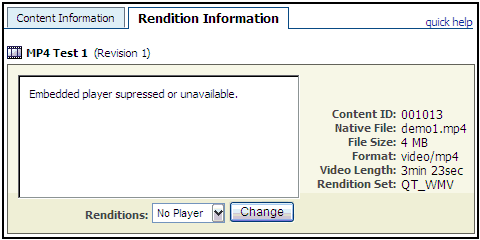
24.9.2 No Player Option
The Player Preference By Format section of the Video Preferences Page enables you to set a video player for each media format included in the list. For example, if you set the preference for Quicktime to be No Format, then this option suppresses that format in the preview area of the Rendition Information Page as illustrated in the following graphic. Click Access this rendition directly to open a new window and play the video using the applicable default player.
Note:
The No Format Option placement always overrides the selected settings for media formats listed in the Player Preference By Format section.
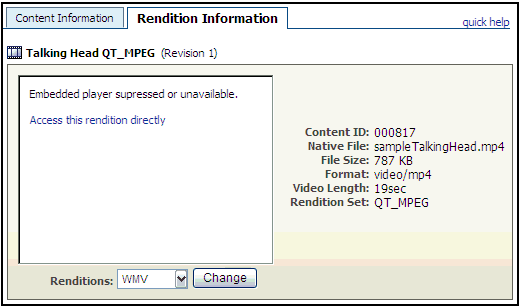
24.10 Working with Renditions
The ability to manage digital assets not only creates renditions automatically, it provides a personal space where you can store renditions you are currently working on, called the digital asset basket. Your digital asset basket is unique to you, and contains only the renditions you choose to include.
You can add items to your digital asset basket from a Search Result page, from the Rendition Information page, or from the Content Information page. To view the items in your digital asset basket, click My Baskets and then Digital Asset Basket in the My Content Server tray.
By design, the digital asset basket can contain renditions from different revisions of the same digital asset. If you use your basket to quickly find a rendition of an asset, such as a corporate logo or video, remember that you may not be accessing the most recent revision of the asset. If a newer revision has been checked in to Oracle WebCenter Content Server, a notification is displayed next to the revision number in the Description column. Click the notification to display the Content Information page of the latest revision.
You can do the following tasks with renditions:
-
Section 24.10.1, "Storing Renditions in Your Digital Asset Basket"
-
Section 24.10.2, "Viewing Items in Your Digital Asset Basket"
-
Section 24.10.3, "Removing Items from Your Digital Asset Basket"
-
Section 24.10.4, "Adding and Removing Renditions in a Rendition Set"
24.10.1 Storing Renditions in Your Digital Asset Basket
You can store any rendition from any revision of a digital asset in your digital asset basket, and the Web-viewable or native file from any revision of a content item, provided the revision is released by Oracle WebCenter Content Server.
From the digital asset basket, you can select renditions from one or multiple assets to be compressed into a single file and downloaded to a local or networked drive, or send links to selected renditions in an e-mail. You can also use the digital asset basket to access the content information and rendition information pages of content items and digital assets.
You can add items to your digital asset basket from the following pages:
-
Rendition Information page (native file and all renditions)
-
Content Information page (native and Web-viewable files only)
-
Search Result page (native and Web-viewable files only)
When you add a rendition to the digital asset basket, it may not be listed at the top of the digital asset basket page. Items in the digital asset basket are listed in descending order first by content ID and then by revision number. If a rendition of a content item revision is in the digital asset basket, additional renditions are added to that revision's listing. Additionally, if a newer revision of a content item in your digital asset basket has been checked in to Oracle WebCenter Content Server, a notification is displayed next to the revision number in the Description column. Click the notification to display the Content Information page of the latest revision.
To add renditions to your digital asset basket from the Rendition Information page, perform these steps:
-
Access the rendition information page of an asset.
-
On the Rendition Information page, select the check box next to a rendition to add the rendition to your digital asset basket.
-
From the Renditions list, choose Add to Basket. The Digital Asset Basket page opens with the renditions you selected listed in the Selected Renditions column of the item.
To add all renditions to your digital asset basket, select all items. You do not have to select the check box next to any rendition if using this option.
To add the native or Web-viewable file to your digital asset basket from the Content Information page:
-
Access the Content Information page of an item.
-
From the Content Actions menu, choose one of these:
-
Add Native File to Digital Asset Basket
-
Add Web-Viewable File to Digital Asset Basket
-
The Digital Asset Basket page opens with the selected items listed in the Selected Renditions column of the item.
You cannot add both the native file and the Web-viewable file to the digital asset basket at the same time using the Content Information page. If the item is a digital asset and has a Rendition Information page, use it to add multiple items to the digital asset basket at the same time.
To add the native or Web-viewable file to your digital asset basket from a Search Result page:
-
From a Search Result page, select the check box next to the item or items you want to add to your digital asset basket.
-
From the Content Actions menu, choose either of these items:
-
Add Native Files to Digital Asset Basket
-
Add Web-Viewable Files to Digital Asset Basket
The Digital Asset Basket page opens with the selected items listed in the Selected Renditions column of the item.
-
To add all native or Web-viewable items on a Search Result page to your digital asset basket, choose All from the Select menu. You do not have to select the check box next to any item if using this option. Also, Web-viewable files of video renditions added to the digital asset basket are suitable for viewing only from the digital asset basket. You cannot download them from the digital asset basket. To download a rendition, use the Rendition Information page.
24.10.2 Viewing Items in Your Digital Asset Basket
To access the digital asset basket, click My Basket and then Digital Asset Basket in the My Content Server tray. From the digital asset basket, you can select renditions from one or multiple assets to be compressed into a single file and downloaded to a local or networked drive, or send links to selected renditions in an e-mail. You can also use the digital asset basket to access the content information and rendition information pages of content items and digital assets.
To access the Digital Asset Basket page, perform these steps:
-
Click the My Content Server tray.
-
Click My Baskets.
-
Click Digital Asset Basket.

| Page Item | Description |
|---|---|
|
Thumbnail |
Opens the Web-viewable rendition in a separate window. Your system administrator specifies the Web-viewable rendition. It is typically larger than the thumbnail or preview renditions. For video assets, you determine the Web-viewable rendition based on the choices you make on the Video Preferences Page. |
|
Description |
Title, native file, Content ID, and Revision metadata of the content item. If a newer revision of the content item has been checked in to Oracle WebCenter Content Server, a notification is displayed next to the revision number. Click the notification to display the Content Information page of the latest revision. |
|
Selected Renditions |
Listing of all renditions of a content item saved to the digital asset basket. |
|
Links to the Content Information page of an item. |
|
|
Links to the Rendition Information Page of an item. |
|
|
Items menu |
|
Items in the digital asset basket are listed in descending order first by content ID and then by revision number. If a rendition of a content item revision is in the digital asset basket, additional renditions are added to that revision's listing.
24.10.3 Removing Items from Your Digital Asset Basket
Because you can store renditions from different revisions of a digital asset in the digital asset basket, renditions listed in the digital asset basket are not necessarily the latest revision. It is a good idea to remove the renditions from your digital asset basket when you no longer require them.
You can store a link to the most recent revision of any content item in Oracle WebCenter Content Server by searching for the item's content ID, then choosing Save Search from the Content Actions menu on the search result page. The link is saved in the My Saved Queries folder in your My Content Server tray. Click the saved search link to always access the most recent revision of a content item.
To remove individual renditions from your digital asset basket:
-
Click the My Content Server tray, click My Baskets, and then click Digital Asset Basket.
-
Select the check box next to the renditions to be removed in the Selected Renditions column on the digital asset basket page.
-
Choose Remove from the Items menu.
The items are removed from the digital asset basket.
To remove all items from your digital asset basket:
-
Click the My Content Server tray, click My Baskets, and then click Digital Asset Basket.
-
Choose Empty Basket from the Items menu.
All items in the digital asset basket are removed. You do not have to select the check box next renditions when removing them all from your basket.
Removing renditions and other items from your digital asset basket does not remove them from Oracle WebCenter Content Server. You can remove renditions and other items from Oracle WebCenter Content Server using the Rendition or Content Information pages. Renditions and other items listed in your digital asset basket are not available if they have been removed from Oracle WebCenter Content Server.
24.10.4 Adding and Removing Renditions in a Rendition Set
The ability to manage digital assets automatically creates multiple renditions of digital assets and manages them in Oracle WebCenter Content Server under one content ID. Oracle WebCenter Content provides the content management and workflow benefits of Oracle WebCenter Content Server while ensuring that you have access to all the types of renditions you need. One content ID provides single-point access to all items relevant to the digital asset.
In some situations, you may want to associate an additional rendition or other file to a digital asset, or remove a rendition that is no longer useful. For example, you may need a rendition that is a slightly different size than the one created by the rendition set, or uses a different color palette, so you want to add the new one and remove the old one. Or, you may have a text file with instructions to a vendor on how they are to use a logo. Files such as these can be added to a digital asset's existing set of renditions using the Add a Rendition page, accessed from the Rendition Information page, and removed directly from the Rendition Information page.
You can access the Add a Rendition page from the Renditions menu on the Rendition Information page of an asset. An added rendition is assumed to be a graphic file, and metadata fields on the Add a Rendition page allow you to manually add information pertinent to graphic renditions. Added renditions can be any type of file, however. For example, if you have a text file with instructions on how to output a PDF file, you can attach the text file as a rendition of the original asset. You should note, though, that Oracle WebCenter Content Server does not manipulate added renditions. It does not modify a rendition based on information entered into the metadata fields, nor does it convert an added rendition to a Web-viewable format, nor index it for searching.
-
Metadata on the Add a Rendition page is for information only. It does not change the size of an added graphic file, and it does not get indexed for searching.
-
You can add any type of file as a rendition. It does not have to be a graphic file. To view added renditions, you must have the native application or suitable viewer for the added rendition's file format.
To add a rendition to an existing rendition set:
-
Access the Rendition Information page.
-
Choose Add New Rendition from the Renditions menu.
-
On the Add a Rendition page, enter a name for the rendition in the Name field (required). The name is displayed in the Rendition Name column of the Rendition Information page.
-
Enter a description for the rendition in the Description field (optional). To display the description, click the Rendition Name Description icon in the Rendition Name column of the Rendition Information page.
-
Click Browse to locate the rendition or other file you want to add to the rendition set (required). You can select any type of file.
-
Fill in the pixel dimensions and resolution information in the Width, Height, and Resolution fields (optional).
-
Click Add Rendition.
Metadata on the Add a Rendition page is for information only. It does not change the size of an added graphic file, and it is not indexed for searching.
To delete a rendition from an existing rendition set:
-
Access the Rendition Information page.
-
Select the check box next to the rendition you want to delete. You can select multiple renditions to delete.
-
Choose Delete from the Renditions menu.
Renditions and other items are not available if they have been removed from Oracle WebCenter Content Server. When you delete a rendition from the system, it disappears from the basket display.
24.10.5 Downloading Multiple Items
You can compress renditions and other content items into a single file and downloaded to a local or networked drive, for example, when you want to send multiple renditions or native files to others. You can do this from the Digital Asset Basket page or Rendition Information page.
To download multiple renditions:
-
Access the digital asset basket or Rendition Information page.
-
Select the check box next to the renditions you want to download. The renditions are listed in the Selected Renditions column of the Digital Asset Basket page, or the Rendition Name column of the Renditions Information page.
-
Choose Download from the Renditions menu on the Rendition Information page or from the Items menu on the Digital Asset Basket page.
-
Follow the download instructions as they are displayed on screen.
Notes:
-
To download all renditions in your digital asset basket, or on the Rendition Information page, select all items, and then choose the Download menu option. You do not have to select the check box next to any rendition if using this option.
-
Web-viewable files of video renditions added to the digital asset basket are suitable for viewing only from the digital asset basket. You cannot download them from the digital asset basket. To download a rendition, use the Rendition Information page.
-
You can remove renditions and other items from Oracle WebCenter Content Server using the Rendition or Content Information pages.
24.10.6 Creating Renditions
Renditions are created automatically when a digital asset is checked in. The types of renditions created are determined by criteria defined in the selected rendition set.
-
Access the Content Check-In Form.
-
Choose a rendition set from the Rendition Set list.
-
Enter a title and any additional metadata for the asset. The title you enter must be 249 or fewer characters in length.
-
Click Browse to locate the primary file.
-
Click Check In.
-
Oracle WebCenter Content Server uses the file extension, such as .psd, .jpg, .mov, or .avi, to determine if an item is a digital asset. You must append the correct extension to the file name for all digital assets checked in to Oracle WebCenter Content Server. For example, a Photoshop file named CorporateLogo.psd is correctly identified by Oracle WebCenter Content Server as a digital asset, but one named CorporateLogo is not.
-
Do not select an alternate file when checking in a digital asset. Doing so prevents the primary file from rendering.
24.10.7 Updating Renditions
If an incorrect rendition set was selected when a digital asset was checked in, or if a new rendition set has been created, you may want to update the renditions created for a digital asset.
To update to a different rendition set, perform these steps:
-
Choose Update from the Content Actions menu on the Content Information page.
-
Choose a different rendition set from the Rendition Set list.
-
Click Submit Update.
-
You cannot display rendition information while an asset is being processed by Oracle WebCenter Content Server. If an asset is being processed, the status in the revision history on the Content Information page is GenWWW, and the Rendition Information page displays a message saying the content item is not released yet.
-
Updating a rendition set replaces the previous renditions with a new set, effectively removing the previous set from Oracle WebCenter Content Server.
24.11 Working with Standard Content Items
The ability to manage digital assets adds functionality to Oracle WebCenter Content Server that extends to content items that are not digital assets. You can add native and Web-viewable versions of content items to your digital asset basket, and add or delete attachments to content items from the Content Information page.
In some situations, you may want to associate an additional rendition or other file to a content item that is not a digital asset, or remove an attachment that is no longer useful. For example, you may attach a customer's new logo to a piece of collateral that uses it and remove the old one, or you may attach a text file with project contact information to a project plan. You can add files such as these to a content item using the Add/Edit Attachments page, accessed from the Content Actions menu on the Content Information page. Attached files are not converted to a Web-viewable format, and are not indexed for searching by Oracle WebCenter Content Server.
| Page Item | Description |
|---|---|
|
Attachment column |
Lists the name given to an existing attached file at the time it was attached. |
|
Description column |
Lists the description given to an existing attached file at the time it was attached. |
|
Name field |
Used to enter the name of the file to be attached. Displayed in the Attachments section of the Content Information page. |
|
Description field |
Used to enter the description of the file to be attached. Displayed in the Attachments section of the Content Information page. |
|
File field |
Used to locate the file to be attached. |
|
Add/Edit Attachment Button |
Submits the information to Oracle WebCenter Content Server. |
To add an attachment to a content item:
-
Access the Content Information page.
-
Choose Add/Edit Attachments from the Content Actions menu.
-
On the Add/Edit Attachments page, enter a name for the attachment in the Name field (required). The name is displayed in the Attachments section of the Content Information page.
-
Enter a description for the rendition in the Description field (optional). The description is displayed in the Attachments section of the Content Information page.
-
Click Browse to locate the rendition or other file you want to attach to the content item (required). It can be any type of file.
-
Click Add/Edit Attachments.
Metadata on the Add/Edit Attachments page is for information only. It does not get indexed for searching.
To delete an attachment from a content item:
-
Access the Content Information page.
-
Choose Add/Edit Attachments from the Content Actions menu.
-
On the Add/Edit Attachments page, select the check box next to the attachment you want to delete. You can select multiple attachments to delete.
-
Click Edit Attachments.
24.12 Managing Digital Assets on a Macintosh Client
Oracle WebCenter Content Server renders digital assets when checked in using a Macintosh client provided the file name of the asset has a valid file extension. However, files created on Macintosh operating systems before OS X may have information stored in a file resource fork. Information in a resource fork may include custom fonts used by the file and is not transferred.
Depending on your organization's requirements, removing the resource fork generally does not create a problem. One exception to this is if the asset uses custom fonts and the rendition set includes a PDF rendition.

